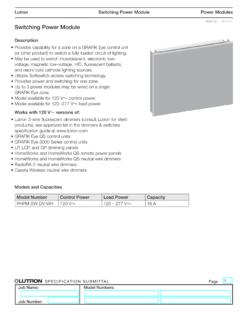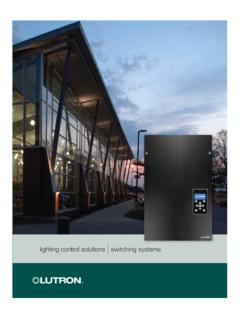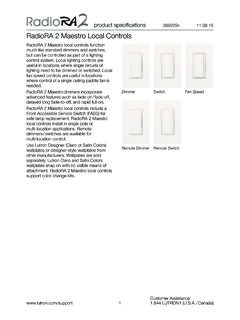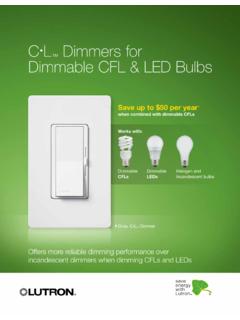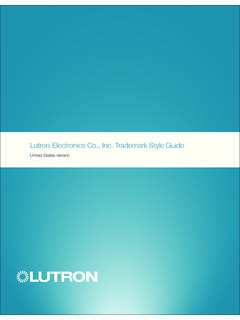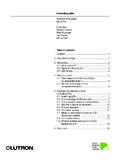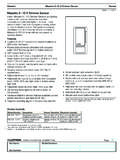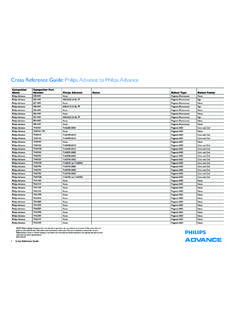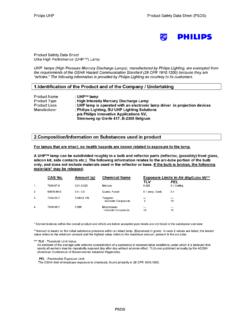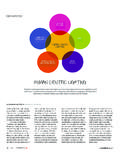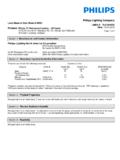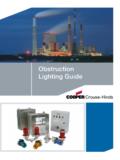Transcription of Color Tuning with Lutron Controls APP NOTE (048579)
1 Color Tuning with Lutron ControlsApplication Note #579 Revision DMay 20171 Customer Assistance Figure 2: Color space with black body locus and lines of constant Color temperature (Tc)Figure 1: Heated piece of iron showing the black body Color temperaturesPurposeColor Tuning is the concept of changing the Color of LED lighting for a variety of purposes such as presentations, comfort and well-being. Color Tuning has evolved significantly with the development of LEDs (or solid state lighting SSL) and is being designed into both residential and commercial applications. In these applications, the Color of the light being controlled can be modified to create a variety of environments. This application note focuses on the three predominant Color Tuning techniques, methods, and solutions on how to achieve them with Lutron Controls and Dim to warm is the capability of reducing the Color temperature of a light source in proportion to the intensity.
2 This mimics the Color shift of incandescent lamps as they are dimmed to a lower intensity (warmer Color temperature at lower light levels, cooler Color temperature at higher light levels).2. Tunable white is the capability of achieving any Color temperature at any intensity of a light source, within specified Full Color Tuning is the capability to change the relative mixture of multiple independent base colors (such as red, green, and blue) within a single source of a to the way white paint comes in different shades, white light has its own variations known as Color temperature. Color temperature is defined as the light emitted by a black body radiator at different temperatures, and is measured in degrees Kelvin (K).
3 Lower Color temperature (red/orange) light is described as warm (for example 2200 K) and higher Color temperature (blue/white) light is described as cool (for example 5000 K). Figure 1 depicts a heated piece of iron, a black body radiator. Depending on the temperature of the piece of iron, different Color temperature light is emitted. Incandescent lamps are also black body radiators and emit light at different Color temperatures depending on their intensity. Although neither fluorescent nor LEDs are black body radiators, we still refer to their light output as having a Color temperature. Therefore, the term correlated Color temperature (CCT) is used to correlate a non-black body radiator to the Color temperature emitted by an equivalent black body radiator.
4 Figure 3 depicts a Color temperature curve for an incandescent lamp over different intensity visible Color spectrum describes all of the colors in the portion of the electromagnetic spectrum that are visible to the human eye. These include primary colors such as red, green and blue as well as all of the possible colors that result when these colors are mixed. However, white light can also be achieved by mixing select colors together (such as red, green and blue). The ratio of how the colors are mixed determines the Color temperature. Figure 2 depicts a chromaticity space with an overlay for the black body locus and lines of constant Color (K) temperature, coolest colorLower temperature, warmest colorLowest temperature, no visible emissionxyWavelengthColor temperature of a black body Application Note #579 Dim-to-WarmWhen turned on at full output, the filament of an incandescent lamp glows white hot, the Color temperature of which varies from about 2700 K to 3000 K, depending on the lamp.
5 Dimming a filament naturally cools the filament, moving it back to yellow then red the further you dim. This gives a warmer light at lower levels, preferred for intimate settings and producing a calming feeling. People are familiar with this behavior and expect it, especially in residences, restaurants and similar spaces. To mimic the behavior of incandescent lamps, LED light sources capable of dim-to-warm dimming will mix two or more LEDs of different colors in an attempt to emulate the Color temperature of an incandescent lamp throughout its dimming curve. Figure 3 depicts CCT curves for an incandescent lamp and USAI Lighting s fixtures equipped with their Warm Glow Dimming capable of dim-to-warm require only one control input.
6 The LED driver translates the control input into the appropriate intensity and Color temperature. For LED lamps ( screw-based LEDs with integral drivers), the control input is typically forward- or reverse-phase line-voltage control . Figure 4 shows an example of a Lutron Diva C L dimmer controlling Philips DimTone LED. Compatibility testing was performed by Lutron s LED control Center of Excellence to ensure high quality dimming between the Diva C L dimmer and Philips DimTone lamps. Visit Lutron s LED control Center of Excellence ( or 1-877-346-5338) for more C L dimmer options and compatible LED from 2700K or 3000K down to 2200K. The result is virtually indistinguishable from an incandescent light source. Color ANALYSIS100W A19 Incandescent Lamp32W BEVELED PERFORMANCE SUMMARYDIMMING CURVE Light Output 100% 50% 20% 1% Full on Dimmed to: Full on Dimmed to:Light Output 100% 50% 20% 1%BeveLED CCT 2700K 2600K 2450K 2200K100W A19 Lamp CCT 2800K 2600K 2400K 2000 KSource Lumens 1750 875 350 18 Delivered Lumens 1485 745 300 15 All figures shown are based on the 32W BeveLED 2700K LED Warm Glow Dimming light engine.
7 USAI Lighting Warm Glow Dimming to know more? Download a PDF at by US patent numbers 8,456,109 and 8,581,520 Figure 3: CCT curves for incandescent lamp and USAI Lighting luminaire with Warm Glow Dimming technologyFigure 4: Lutron Diva C L dimmer controlling Philips DimTone LEDDiva C L Dimmer (DVCL-153P-XX)Philips W BR30 DimTone with dim-to-warm LEDM odel#: 9290011117 Forward-Phase Control3 Customer Assistance Application Note #579 Considerations when specifying Lutron Controls with dim-to-warm applications:1. Ensure the LED lamp or fixture is capable of dim-to-warm Understand the control technology required to control the lamp or fixture ( forward-phase control , reverse-phase control , 0-10V, etc.). This is typically found in the lamp or fixture spec Select a control that utilizes the appropriate control technology, and confirm compatibility of the control with the LED lamp or fixture by checking with the control and LED manufacturer.
8 Lutron s LED control Center of Excellence ( ) tests for compatibility between Lutron Controls and phase- control LED lamps and fixtures and provides compatibility report cards to ensure solutions are specified correctly and the highest quality dimming is achieved. Additionally, Lutron s High Performance Fixture List tool ( ) is designed to help you find fixtures available with Lutron LED drivers. 4. Ensure that factors such as inrush currents and repetitive peak currents have been taken into account such that the minimum and maximum number of loads are correctly specified. A compatibility report card, such as those available from Lutron s LED control Center of Excellence, should provide this. Additionally, look for Controls and LED drivers that have been tested to comply with NEMA 410, which defines a maximum expected inrush current.
9 5. Be aware that the simulated warm dimming behavior of LED light sources may not exactly match that of existing incandescent lamps and may show variations from one manufacturer to the LED fixtures where the LED light engine and driver are separate, the control input can include phase control as well as 0-10V or digital inputs (such as Lutron EcoSystem, DALIR, or DMX512). Figure 5 depicts a Lutron GRAFIK Eye QS with EcoSystem controlling USAI Lighting s BeveLED downlight with Warm Glow Dimming installed with a Lutron EcoSystem LED driver. The benefit to using a digital control scheme like Lutron EcoSystem is that the power and control wiring can be run separate and the fixtures can be grouped and zoned through software without needing to change line-voltage wiring.
10 Figure 5: Lutron GRAFIK Eye QS unit controlling USAI Lighting BeveLED fixtures with Warm Glow Dimming installed with Lutron EcoSystem LED driversUSAI Lighting BeveLED Downlight with Warm Glow Dimming installed with Lutron EcoSystem LED Driver and dim-to-warm functionalityLutron EcoSystemLutron GRAFIK Eye QS with EcoSystem (QSGRJ-xE)120-277 V~ Lutron EcoSystem driver installed in fixture by USAI120 V~ Application Note #579 Tunable WhiteLight sources have historically been purchased with a specific Color temperature. This is particularly true for fluorescent lamps, which have been the primary commercial light source for decades. However, there are emerging studies on the health, comfort and productivity benefits of being able to change, or tune, the Color temperature of a light source.
